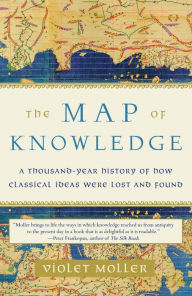Download ebook file txt The Map of Knowledge: A Thousand-Year History of How Classical Ideas Were Lost and Found by Violet Moller
Par wood donnell le dimanche, octobre 18 2020, 21:42 - Lien permanent
The Map of Knowledge: A Thousand-Year History of How Classical Ideas Were Lost and Found. Violet Moller

The-Map-of-Knowledge-A-Thousand.pdf
ISBN: 9780385541763 | 336 pages | 9 Mb

- The Map of Knowledge: A Thousand-Year History of How Classical Ideas Were Lost and Found
- Violet Moller
- Page: 336
- Format: pdf, ePub, fb2, mobi
- ISBN: 9780385541763
- Publisher: Knopf Doubleday Publishing Group
Download ebook file txt The Map of Knowledge: A Thousand-Year History of How Classical Ideas Were Lost and Found by Violet Moller
“The Map of Knowledge is an endlessly fascinating book, rich in detail, capacious and humane in vision.” —Stephen Greenblatt, author of The Swerve: How the World Became Modern, winner of the Pulitzer Prize After the Fall of Rome, when many of the great ideas of the ancient world were lost to the ravages of the Dark Ages, three crucial manuscripts passed hand to hand through seven Mediterranean cities and survived to fuel the revival of the Renaissance--an exciting debut history. The foundations of modern knowledge—philosophy, math, astronomy, geography—were laid by the Greeks, whose ideas were written on scrolls and stored in libraries across the Mediterranean and beyond. But as the vast Roman Empire disintegrated, so did appreciation of these precious texts. Christianity cast a shadow over so-called pagan thought, books were burned, and the library of Alexandria, the greatest repository of classical knowledge, was destroyed. Yet some texts did survive and The Map of Knowledge explores the role played by seven cities around the Mediterranean—rare centers of knowledge in a dark world, where scholars supported by enlightened heads of state collected, translated and shared manuscripts. In 8th century Baghdad, Arab discoveries augmented Greek learning. Exchange within the thriving Muslim world brought that knowledge to Cordoba, Spain. Toledo became a famous center of translation from Arabic into Latin, a portal through which Greek and Arab ideas reached Western Europe. Salerno, on the Italian coast, was the great center of medical studies, and Sicily, ancient colony of the Greeks, was one of the few places in the West to retain contact with Greek culture and language. Scholars in these cities helped classical ideas make their way to Venice in the 15th century, where printers thrived and the Renaissance took root. The Map of Knowledge follows three key texts—Euclid's Elements, Ptolemy's The Almagest, and Galen's writings on medicine—on a perilous journey driven by insatiable curiosity about the world.
The Map of Knowledge by Violet Moller | Books on Tape
A Thousand-Year History of How Classical Ideas Were Lost and Found Yet some texts did survive and The Map of Knowledge explores the role played by
The Map of Knowledge: A Thousand-Year History of How Classical
Buy The Map of Knowledge: A Thousand-Year History of How Classical Ideas Were Lost and Found by Violet Moller (ISBN: 9780385541763) from Amazon's
History of science and technology in China - Wikipedia
Ancient Chinese scientists and engineers made significant scientific innovations, findings and Much of the early Western work in the history of science in China was done by The Warring States period began 2500 years ago at the time of the invention of the crossbow. . Ships of the world in 1460 (Fra Mauro map).
History of Latin America - Wikipedia
The term "Latin America" primarily refers to the Spanish and Portuguese- speaking countries in A 17th-century map of the Americas The idea was later taken up by Latin American intellectuals and political leaders of the mid- . Paula was tried in 1624 and began her hearings without much knowledge of the Crowns way
The Map of Knowledge: A Thousand-Year History of How Classical
After the Fall of Rome, when many of the great ideas of the ancient w of Knowledge: A Thousand-Year History of How Classical Ideas Were Lost and Found
Introduction to the middle ages | Art history (article) | Khan Academy
Broadly speaking, the Middle Ages is the period of time in Europe between the end of the Renaissance, or rebirth of classical learning, in the fifteenth century and sixteenth centuries. c.1000-1200 – Romanesque Art . 6 years ago in the Middle Ages, when evidence of the opposite can be found all around Europe.
New Chronology (Fomenko) - Wikipedia
The New Chronology is a pseudohistorical theory which argues that the conventional The central concepts of the New Chronology are derived from the ideas of Russian AD 800–1000, and most known historical events took place in AD 1000–1500. . For each analysed text, a function is devised which maps each year
Library of Alexandria | Description, Facts, & Destruction | Britannica
The library was named after Alexander the Great, who initiated the Library of Alexandria, the most famous library of Classical antiquity. The idea of a universal library, like that of Alexandria, arose only after There is literary evidence of Greek individuals visiting Egypt especially to acquire knowledge:
History of astronomy - Wikipedia
Astronomy is the oldest of the natural sciences, dating back to antiquity, with its origins in the religious, mythological, cosmological, calendrical, and astrological beliefs and practices of prehistory: vestiges of these are still found in astrology, a discipline long interwoven with . Our knowledge of Sumerian astronomy is indirect, via the earliest
Pdf downloads:
Free ebook download in pdf format How to Have Confidence and Power in Dealing with People 9780988727533 English version
Ipod téléchargements gratuits livres audio Klaw - tome 11 par Joël Jurion, Ozanam
Mejores descargas gratuitas de libros electrónicos The Other End of the Line: An Inspector Montalbano Mystery